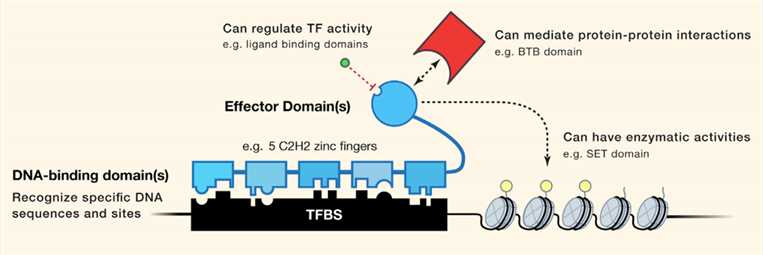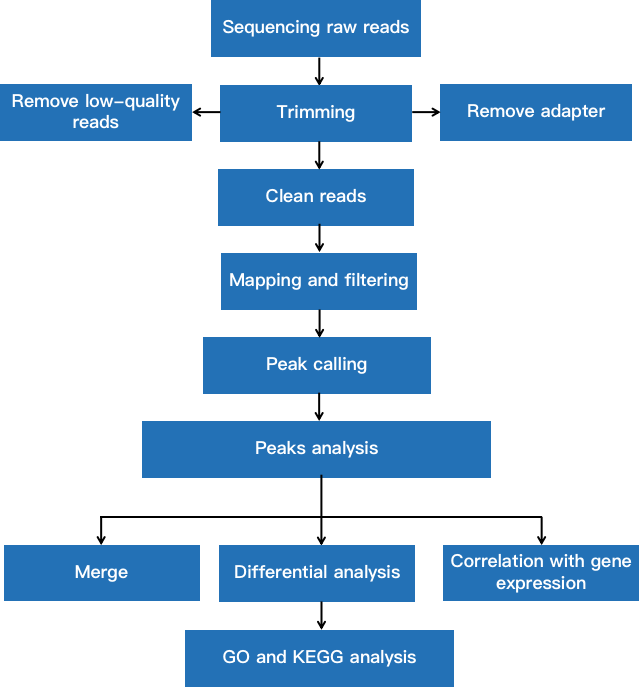Transcription Factor Binding Site Analysis
With years of bioinformatics data analysis services, CD Genomics provides scientists with fast, efficient and comprehensive transcription factor data analysis services, and accelerates their research on human physiology, diseases and mutations by understanding the gene regulation mediated by transcription factors.
Introduction
The regulation of gene expression is an important research content in the post-genomic era. Among them, transcription factors regulate the gene transcription process by specifically binding to the DNA sequence of the regulatory region. Transcription Factors (TFs) refer to protein molecules that can be specifically combined with a gene with a specific sequence to ensure that the target gene is expressed at a specific time and space with a specific strength. Transcription factors control chromatin and transcription by recognizing specific DNA sequences to form a complex system that directs genome expression. Many transcription factors act as master regulators and selection genes, controlling the process of cell type decision, development mode and specific pathway control (such as immune response). Transcription factor binding sites (TFBs) are DNA fragments that bind to transcription factors. The length is usually in the range of 5-20 bp. A transcription factor often regulates several genes at the same time, and its binding sites on different genes. The points are somewhat conservative, but they are not exactly the same. Understanding the interaction between transcription factors and binding sites is the key to understanding transcriptional regulatory mechanisms and building transcriptional regulatory networks.
 Fig 1. Schematic of a prototypical Transcription Factor (TF). (Lambert SA, et al. 2018)
Fig 1. Schematic of a prototypical Transcription Factor (TF). (Lambert SA, et al. 2018)
Application of Bioinformatics Technology in Transcription Factor Research
In the process of transcription factor research, it is difficult to complete the functional research of massive genome non-coding region sequences through experimental analysis. With the completion of the sequencing of the human genome and multiple model animal genomes, as well as the continuous improvement of various analysis procedures, the computer-aided analysis method, or bioinformatics method has been more and more widely used in this field. A large number of experiments and calculation results show that bioinformatics methods can successfully screen out transcriptional regulatory elements from a large number of non-coding regions to provide guidance for further experiments. With the increasing enrichment of genome sequence information, the continuous improvement of calculation methods and databases, the application of bioinformatics will become increasingly widespread, and the transcription factors in the genome sequence will gradually be clarified.
What We Offer
Biomedical-Bioinformatics, a division of CD Genomics, provides transcription factor binding site analysis on the data generated by different transcription factor identification experiments. Common experimental methods for transcription factor analysis include chromatin immunoprecipitation followed by sequencing (ChIP-seq) and DNA affinity purification sequencing (DAP-seq). CD Genomics provides different software or packages to perform transcription factor analysis and visual analysis for researchers to meet their personalized needs. In addition, you only need to provide us with your original data (including NGS data or microarray data) or other intermediate data files. We will evaluate the data, preprocess it, identify transcription factors and the transcription factor sites, and finally generate a complete report, in which high-quality and easy-to-interpret images and tables can be used for publication of the article.
Data Analysis Technical Route
 Fig 2. Transcription factor binding site bioinformatics analysis pipeline.
Fig 2. Transcription factor binding site bioinformatics analysis pipeline.
Data Ready
Before data analysis, the first thing is to get your data ready, the raw input data can be experimental raw data generated in your own laboratory or that of a 3rd party provider or downloaded from public databases.

For protein transcription factor binding site analysis services, if you have any questions about the data analysis cycle, analysis content and price, please click online inquiry.
What's More
For transcription factor binding site analysis, if you have yet to generate the raw data, CD Genomics relies on years of experience in gene regulation services to provide you with different transcription factor wet experiment services and sequencing services. In addition, we also provide services to obtain raw data from public databases. Totally, we are happy to work with you at every stage of your research to ensure the best outcome for your study. For transcription factor binding site analysis, if you have any questions, please feel free to contact us for details.
Reference
- Lambert SA, et al. The Human Transcription Factors[J]. Cell. 2018 Feb 8;172(4):650-665.
* For research use only. Not for use in clinical diagnosis or treatment of humans or animals.
Online Inquiry
Please submit a detailed description of your project. Our industry-leading scientists will review the information provided as soon as possible. You can also send emails directly to for inquiries.
